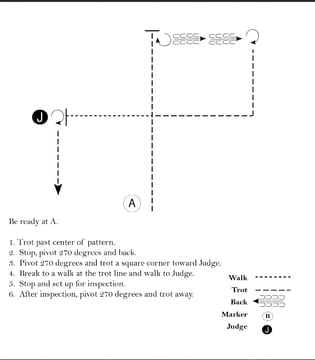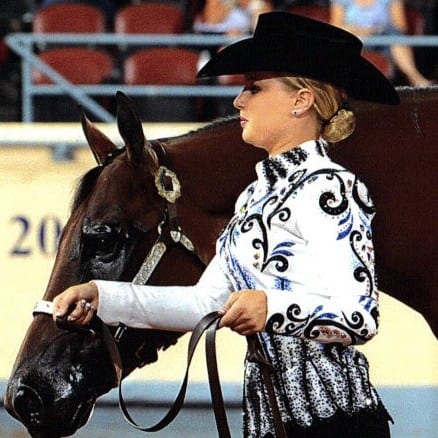The last in our Congress Pattern Series is breaking down the Amateur Showmanship pattern. AQHA judge Tina Anderson of Millsap, Texas has agreed to share her advice on how to approach this challenging pattern. Tina’s daughter, Bailey Anderson, competes successfully on a national level where she has several Congress top five placings in the showmanship. Anderson has been an AQHA judge since 2000 and also holds judging credentials with NSBA. She has judged the AQHA Amateur World Show, AQHA Youth World Show, AQHA European Championship Show and recently judged the inaugural AQHA Novice Championship Show.
“I love the showmanship. It is the judge’s chance to get up close and personal with the exhibitor. It allows an exhibitor a chance to demonstrate their connection with their horse. I love the precision of the class!” Tina says.
We would also like to thank HorseShowPatterns.com for letting us post the pattern in the article. Please print out the pattern and follow along if that would be easier.
As
far as why GoHorseShow chose the Amateur Showmanship pattern, we
wanted to breakdown the harder patterns due to the easier patterns
having many of the same maneuvers.
Major Tips from Tina Anderson:
- When approaching a showmanship pattern, the exhibitor needs to not only think about how they will lay out the pattern and their plan of attack, but also the judges’ perspective. Knowing how the judge evaluates and breaks down the pattern can ultimately have an impact on how you score.
- When a judge reads the Amateur Showmanship pattern, they will instantly notice that there is only one cone and the judge. Having only two marking spots in the pattern will mean that the exhibitor will have liberty in how they lay out the pattern in the arena. Speaking of arenas, this pattern shows in the Cooper Arena, the smallest and tightest arena on the grounds. Keep that in mind as you prepare and practice!
- The judges will most likely discuss the pattern as a group and work with the ring steward that will be performing the inspection of the exhibitors. They will most likely break the pattern down into separate maneuvers for their score sheets and agree on the same maneuvers. They may utilize the 6 maneuvers listed in this pattern description, or decide to combine a maneuver or two and make a total of five maneuvers. Be cognizant of this as you perform your pattern, making sure each of the 5 or 6 maneuvers is sharp and accurate.
-
 As a judge, when I look up at the cone, I form my first impression. I mentally have a score range in mind before the exhibitor even moves. An exhibitor that is ready, presenting their horse, smiling, and confident, standing tall and presenting a horse that is alert, square, calm and well-groomed is automatically starting in a high range. An exhibitor that is picking at their horse’s set up, poorly dressed, not ready, fidgeting at the cone or has a horse that is excitable or asleep, not square, etc., will automatically start in a lower range. How the exhibitor executes the pattern from there will determine whether their score goes up, down, or stays in the same range.
As a judge, when I look up at the cone, I form my first impression. I mentally have a score range in mind before the exhibitor even moves. An exhibitor that is ready, presenting their horse, smiling, and confident, standing tall and presenting a horse that is alert, square, calm and well-groomed is automatically starting in a high range. An exhibitor that is picking at their horse’s set up, poorly dressed, not ready, fidgeting at the cone or has a horse that is excitable or asleep, not square, etc., will automatically start in a lower range. How the exhibitor executes the pattern from there will determine whether their score goes up, down, or stays in the same range.
- The exhibitor will start this pattern from the off side of the horse, so when they get the nod, they will move to the left side of the horse and trot off. The judge is looking for an exhibitor that moves naturally around their horse and into position to trot. The trot line should be straight and will give the judge a great first impression of the exhibitor’s style and confidence. The exhibitor should be giving their horse direction and show connection to their horse. According to the drawing, the exhibitor should trot an equal distance before and after the judge. Again, how the exhibitor lays out this pattern is key to their score.
- Stop, pivot 270 degrees and back. The stop should be square and credit will be given for the showman that is connected to their horse and stops in unison. Some judges prefer a hard stop and some prefer a softer stop. Whatever your style, it is imperative that you are giving your horse direction and stopping in unison, showing team work. It goes without saying that the 270 pivot should be performed around the right hind foot and any step out will be heavily penalized. Your horse should also be straight and you should be in an appropriate position guiding your horse around the turn. The finish of this turn in imperative to getting in the correct position for the back-up. Stop so that your horse is positioned to back in a straight line, perpendicular to the start trot-line. Completely finishing before backing will show the judges you have confidence and a plan.
- The back-up can be a make or break section of the pattern for many. A lot of things tend to go wrong in the back-up. Again, knowing the pattern and how you plan to lay it out will help you execute this maneuver with precision. You should back your horse the same distance that you trotted past the judge in maneuver #1. It is the second side of what should be a perfect square. How well do you know your horse? How many trot steps do you take per horse length? How many back steps do you take per horse length? You will want to ensure that each section of the square is the same length. Complete your back up before progressing to maneuver #3. Judges do not expect you to have your horse square once he/she completes the backup, but you should be sure you are balanced and in position to move on. This also shows that you have a plan.
- Pivot 270 degrees and trot a square corner toward the judge. Again, the 270 should be accurate and stylish. Completely close your turn. Otherwise you will be out of line to trot straight. Again, the length of each side of the square needs to be of equal distance. A square corner is exactly that; square. Be careful that your horse’s shoulder doesn’t drop and/or break gait. You may need to compensate in your stride to make the corner around with your horse. Start counting steps again as you make the corner and look for the mark where you will break to the walk.
- Break to the walk at the trot line and walk to the judge. This is another area the judges will be closely watching. Not only is it imperative to break at the appropriate mark, but often we see horses continue to trot alongside the exhibitor when he or she is walking. Credit will be given to the team that is connected and moving together at this section of the pattern. Walk with confidence up to the judge and be pleasant! This is a great moment to leave a positive impression!
- Stop and set up for inspection. At this point in the pattern, the judges are getting a close up view of horse and exhibitor. Are they well-groomed? Do their clothes fit? Are they confident and sure of themselves? These are all things that run through a judge’s mind at the time of inspection. The set-up is crucial. There is always much debate about the time it takes to set up your horse. I have never worked with a judge that didn’t prefer an accurate set up that takes a few seconds longer over a rushed sloppy set up. The purpose of this class is to SHOW your horse, and a sloppy poor set-up will be penalized! Move with confidence and ease around your horse. Most judges prefer a more natural exhibitor, rather than one that is bouncy, animated and artificial. It goes without saying that the exhibitor must change sides at appropriate times for a credit earning run.
- After inspection, pivot 270 degrees and trot away. The third 270 should be executed as correctly and first two, closed completely and not rushed. You may be anxious to be done with this pattern, but this last maneuver is just as important as the first! Make sure you are not rushed and risk stepping out of your turn or approaching your last trot line from a crooked position.
- Overall, the judge is looking for a team in the showmanship. The exhibitor should be confident and giving their horse direction. Never forget that this class is intended to highlight your ability to SHOW your horse. Have a plan. Style, accuracy and confidence will earn you credit and set you apart from the very large pack at the Congress! Good luck!







